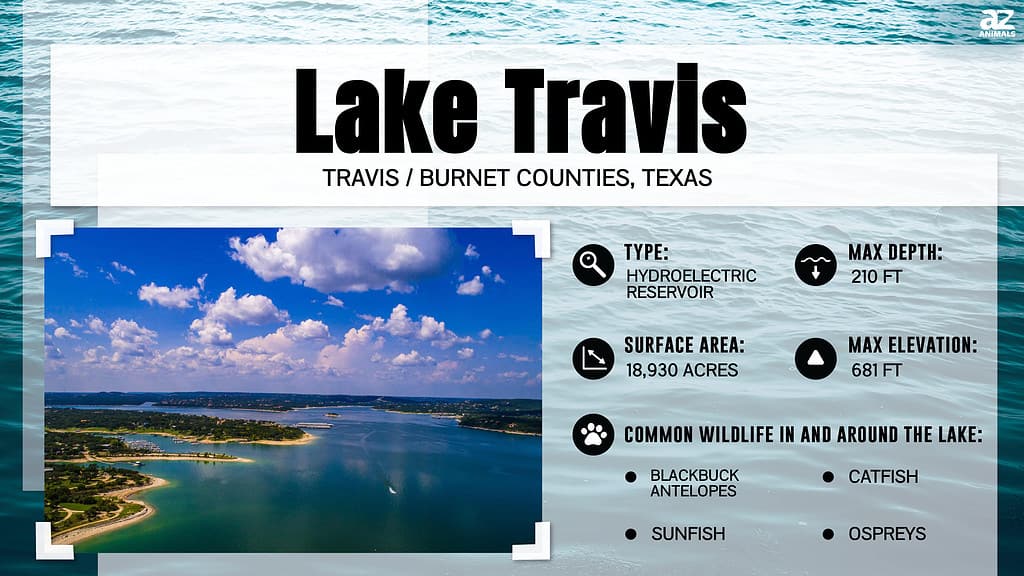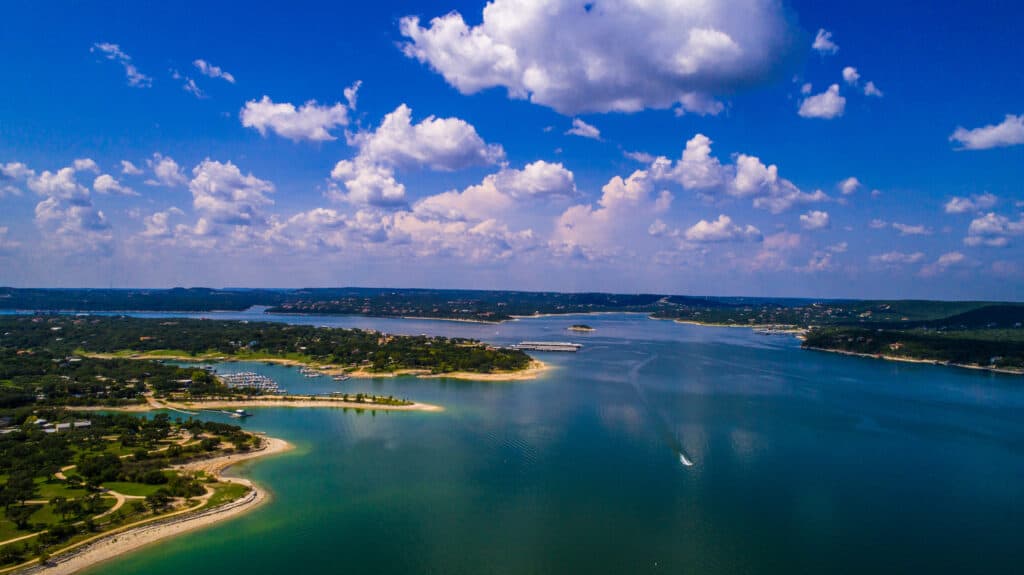As a native Texan, I can confirm the struggle is real when it comes to finding fun outdoor activities in the summertime. Temperatures reach above 100 degrees starting as early as May and last through September. For this reason, any destination with a source of water is a coveted commodity. One of the lesser-known jewels of Central Texas is Lake Travis.

Less than a 45-minute drive from Austin, Lake Travis is the perfect getaway. It has countless forms of recreation such as boating, fishing, lakeside parks, zip lines, waterparks, swimming, and more!
Originally, Lake Travis was created when the construction of the Mansfield Dam was completed in 1942. Not only does it serve as crucial flood control for the area, but also as irrigation, water supply, and source of hydroelectricity.
Aside from what you’d typically expect from a popular Lake destination, there are a few surprising facts about Lake Travis you probably didn’t know. Keep reading to find out some lesser know details about this beloved retreat that’s also home to thousands of residents in the area.
How Deep Is Lake Travis?
The typical depth of the lake is 62 feet when full, however, between Hudson Bend and Volenta the depth reaches 210 feet, which is almost 20 stories tall! The surface area measures a whopping 18,930 acres and it has over 270 miles of shoreline for plenty of fun and activities. Additionally, Lake Travis is considered to be one of the clearest lakes in Texas and is stocked with several species of fish, along with bass, catfish, and sunfish, which provide a great source of recreational fishing. Not only is Lake Travis a crucial supply of water for the City of Austin, but it also supplies water to the greater developing urban area.

Lake Travis measures 18,930 acres and has over 270 miles of shoreline.
©Roschetzky Photography/Shutterstock.com
Here are five more incredible facts about this Texas lake:
1. Lake Travis isn’t a lake!
Sometimes a name is deceiving … Lake Travis isn’t a lake at all! It’s a reservoir. Some differences between a lake and a reservoir are that it’s an artificial lake that’s built using a dam, or, it’s an already natural area that’s been enlarged. While there are different ways to create a reservoir, Lake Travis was created when the Lower Colorado River Authority (LCRA) constructed the Mansfield Dam to aid in flood control. The areas surrounding the Colorado River had long been prone to flooding and Lyndon B. Johnson spearheaded a campaign for the construction of the dam. Many people often think Texas is a mostly arid landscape, however, that’s hardly the case. There are many different lakes, reservoirs, rivers, creek ways, and hidden oases throughout the Lone Star State.
2. Lake Travis is part of the Highland Lakes.
Located in Central Texas, the Highland Lakes aren’t naturally occurring lakes but rather reservoirs. The Lower Colorado River Authority (LCRA) commissioned the dams during the 1930s and 1940s as preventative measures to combat flooding from the Colorado River. All the Highland Lakes are fresh water and of the 6 lakes, Lake Travis holds the most water. All Lakes are a source of hydroelectricity however Lake Travis and Lake Buchanan contribute the most production capacity. Though Lake Travis won’t power the city of Austin, it can respectfully supply approximately 20,00 households with electricity on a good day. Once wind energy began to take off the LCRA created a separation enterprise to purchase power from the Gulf and West Texas, as well as built towers to transfer electricity to additional locations. Currently, the LCRA is the biggest distributor of renewable power in Texas.
3. Lake Travis contains tons of water.
At its maximum capacity, Lake Travis contains approximately 1.1 million acre-feet of water, which is nearly 363 billion gallons, or over 11.5 billion tons of water! The lake can be quite deceiving if you’re used to wading out in gradually deeper water on typical sandy beaches, as here you may only step out a few feet before you encounter steep drop-offs of 8 ft or more. However, it’s easy to ensure you can safely enjoy your time in the water by simply wearing a life jacket. Additionally, during heavy rains, the LCRA is responsible for the management and release of water downstream to mitigate the integrity of the dam.
4. Lake Travis isn’t immune to Texas droughts.
Lake Travis experiences significant water level fluctuations as it lies within the Edwards Plateau ecological area and is affected by rainfall upstream in the Colorado River basin. In 2008-2009 the area experienced the worst drought in its history which saw the lake reach its 4th lowest level at 626 feet. Then during the Southern United States drought from 2010-2013, the lake reached its third lowest level of 618 ft. The historical low of 614 ft occurred in 1951, however, by 2016 the lake has resumed full capacity at 681 feet. In comparison, the highest level the lake reached was 710 feet in 1991, which is only 4 feet shy of the dam’s 714 feet spillway.
Needless to say, predicting the weather forecast in Texas is harder than winning the lottery. However, with the urban and residential development over the last few years, there are growing concerns for the future of the lake. With residents of larger cities like Austin flocking to Lake Travis for a slower pace of life, non-profits such as the Central Texas Water Coalition have been established to ensure the water supply of all the Highland Lakes is properly preserved and managed.
5. Hippie Hollow Park is clothing optional.
Hippie Hollow Park, formerly known as McGregor County Park, is a picture-perfect scenery consisting of 109 acres at the eastern edge of Lake Travis. It became popular in the 1960s and has carried on the tradition of being Texas’s only clothing-optional public park. Located in the basin of Lake Travis you can take in the stunning views from the south-facing rocky shoreline, which is a popular spot among locals to sunbathe and swim. As you climb down the rugged limestone steps to the cool and clear water below you’ll forget you’re minutes away from a bustling city. The park is conveniently nestled at the northern shoreline of Lake Travis and has elevations that range from 681 feet at the pool to 860 feet at the far northeast portion. I can confirm you’ll have plenty of privacy as I’ve visited with friends on a few occasions and never felt cramped or uncomfortable as there’s plenty of space. So if you’re looking to relax, leave your worries and clothes behind, then take the time to visit this lesser-known hideaway at Lake Travis. Adults 18 and older are welcome and a small fee is collected upon arrival.

Wildlife abounds at Lake Travis! Pictured, a Cattle Egret in a bed of bluebonnets on the shores of the lake.
©Richard A McMillin/Shutterstock.com
Where is Lake Travis Located on a Map?
Located in central Texas, Lake Travis is an artificial reservoir on the Colorado River primarily designed for flood control purposes, exhibiting a significant water level fluctuation ranging close to 100 feet from its historical minimum to maximum height.
Here is Lake Travis on a map:
The photo featured at the top of this post is © Richard A McMillin/Shutterstock.com
FAQs (Frequently Asked Questions)
What can I do at Lake Travis?
A little bit of everything! There is lodging, camping, boating, swimming, hiking, dining, breweries, live music, water parks, tours, and more. Lake Travis has a dedicated site listing all the fun you can have that’s managed by locals and contains all their upcoming events.
Is there lodging available at Lake Travis?
Yes! Lake Travis has options for camping, hotels, bed & breakfasts, long-term vacation rentals, and RV Parks. Whether you’re visiting for a day, weekend, or extended vacation, there are plenty of options so you’re sure to find the perfect accommodations for your trip.
Are there places to eat & shop at Lake Travis?
Yes! There are rustic decor & home furnishing stores, fashion boutiques, art galleries, outdoor malls, restaurants & bars, and farmer’s markets, to name a few. You’ll have countless stores to shop and options for dining available.
Thank you for reading! Have some feedback for us? Contact the AZ Animals editorial team.







